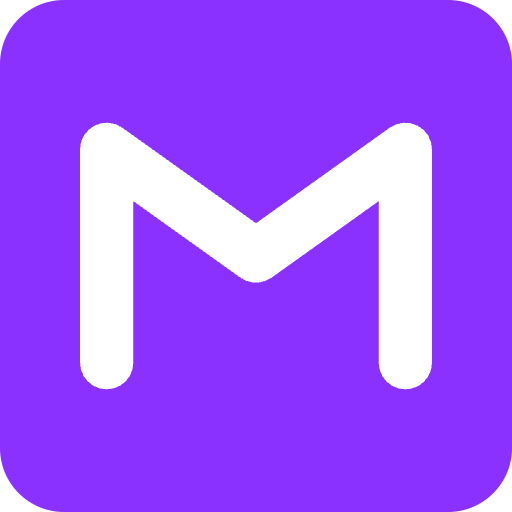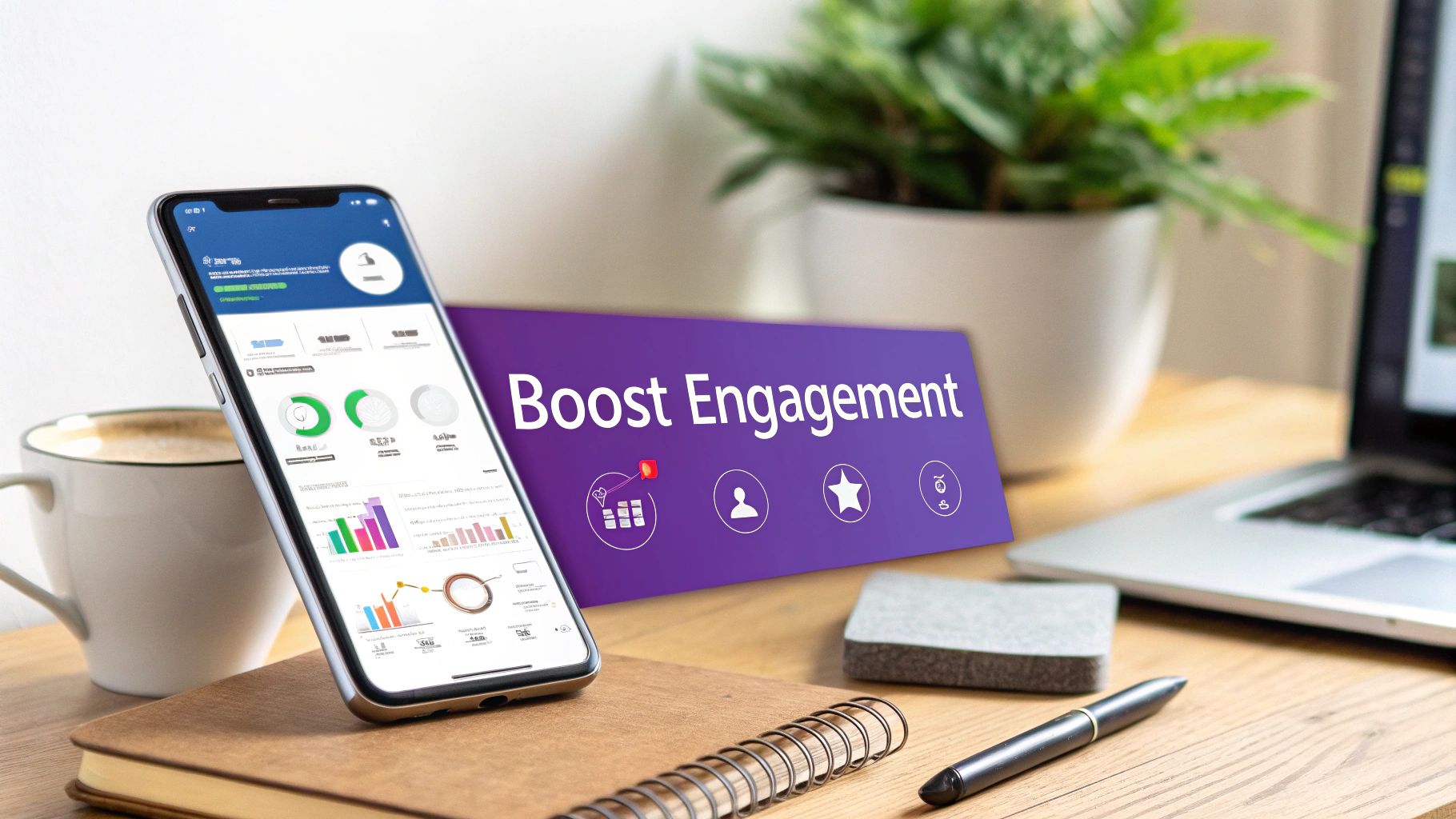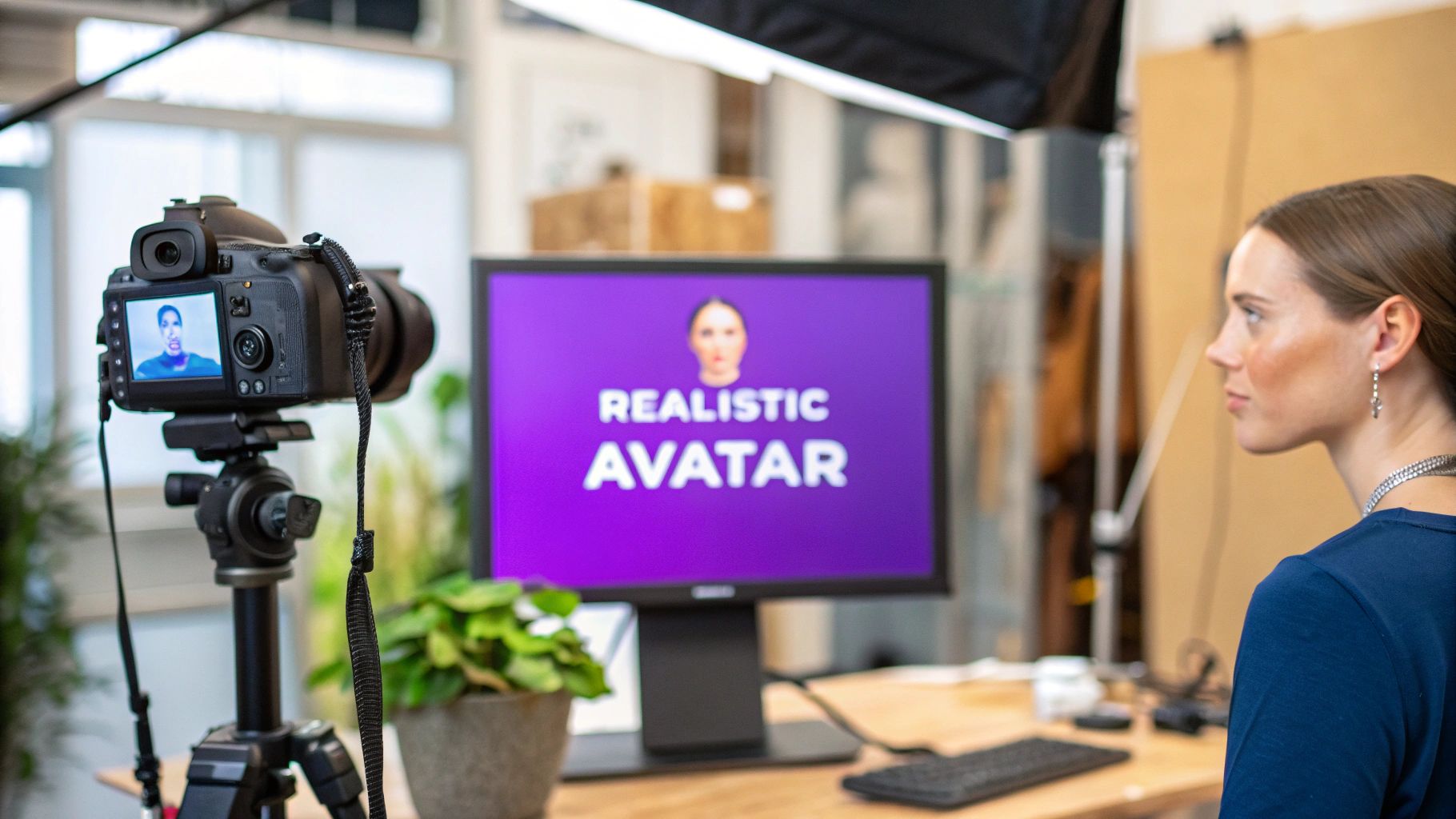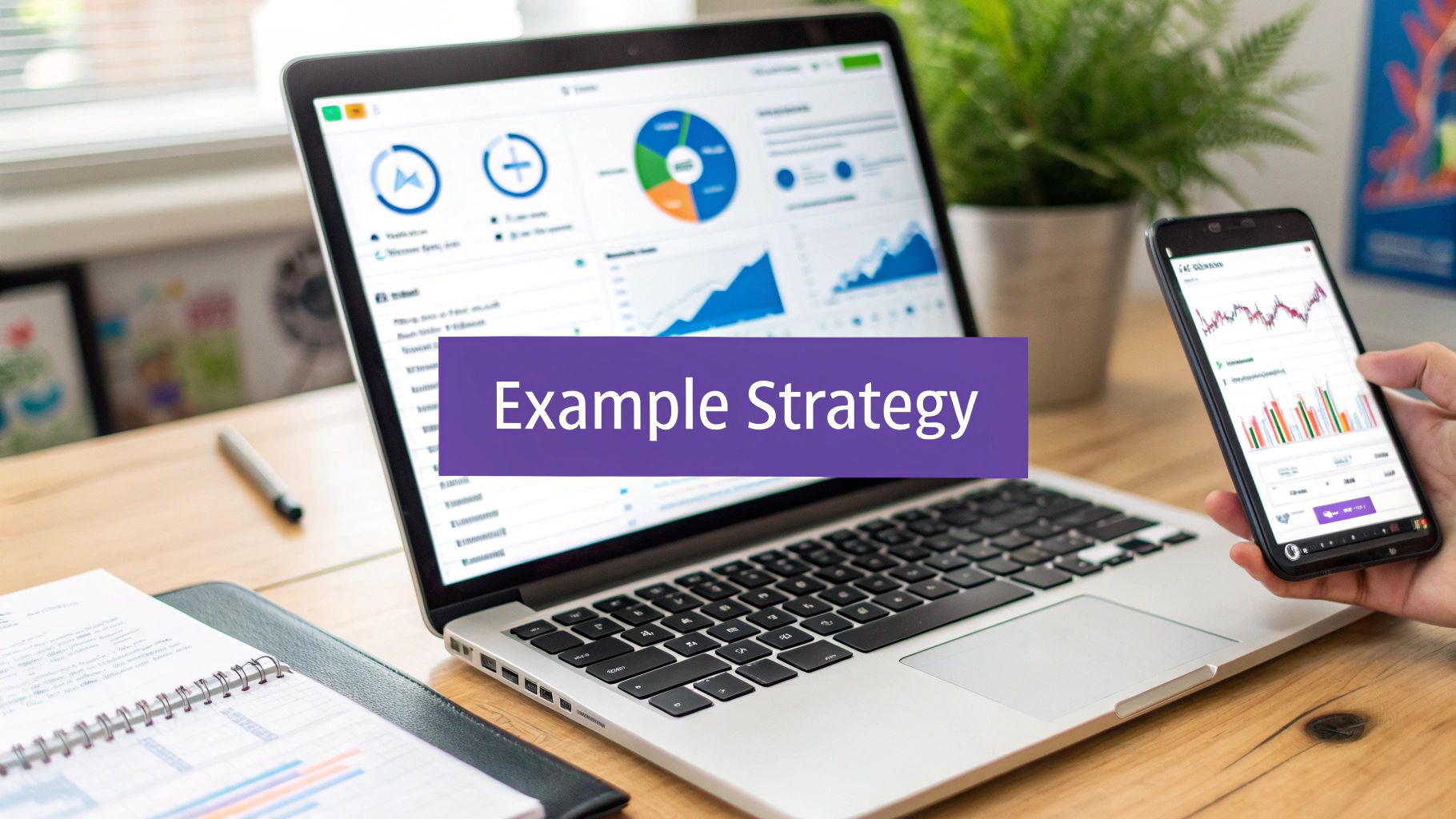6 Professional LinkedIn Summary Examples for 2025

Your LinkedIn summary is the most valuable real estate on your profile. It's more than a simple bio; it's your professional pitch, a strategic narrative designed to capture attention and drive action. A well-crafted professional LinkedIn summary can be the difference between a profile that gets overlooked and one that opens doors to new opportunities, clients, and collaborations. It’s the first real opportunity you have to tell your story, showcase your expertise, and connect with your target audience on a human level.
However, staring at that blank "About" section can be daunting. How do you condense years of experience, skills, and aspirations into a compelling and concise statement? The key isn't just to list what you've done, but to frame it in a way that resonates with the specific people you want to attract, whether they are recruiters, potential clients, or industry peers. While mastering your LinkedIn summary is key, remember that a powerful headline also plays a crucial role in creating a compelling first impression. You can use a tool like a LinkedIn Headline Generator to ensure your entire profile introduction is optimized for impact.
This article cuts through the guesswork. We will dissect six powerful and distinct types of LinkedIn summaries, providing you with real examples and a strategic breakdown of what makes them effective. For each one, we’ll move beyond surface-level observations to reveal the underlying tactics and actionable insights you can apply directly to your own profile. You’ll learn how to transform your summary from a passive resume C.V. into an active, engaging career tool. Get ready to explore proven formulas and frameworks that will help you write a professional LinkedIn summary that truly works.
1. The Hook + Achievement Formula
In the crowded digital landscape of LinkedIn, your summary's first line is prime real estate. The Hook + Achievement Formula is a powerful, direct approach designed to capitalize on this by immediately capturing a reader's attention and proving your value within seconds. It's one of the most effective structures for a professional LinkedIn summary because it replaces vague, subjective statements with concrete, undeniable evidence of your capabilities.
This formula works by leading with a concise, compelling "hook" – a statement of your core professional identity or biggest accomplishment. This is immediately followed by specific, quantifiable achievements that substantiate your claim. Instead of merely listing job duties, you're showcasing the tangible business impact you've made, which is exactly what recruiters, hiring managers, and potential clients are looking for.
Strategic Breakdown and Examples
Let’s analyze how this formula translates into a high-impact summary. The goal is to move from a passive description of your role to an active demonstration of your results.
Example 1: Sales Manager
- Hook: Driving revenue growth and leading high-performance sales teams to consistently exceed targets.
- Achievement: Achieved 200%+ of quota for three consecutive years, expanding market share in the SaaS sector by 45% and securing a $5M keystone client account.
Why It Works: The hook establishes a clear area of expertise. The subsequent achievements are not just impressive; they are specific, using percentages and dollar amounts to quantify success. This leaves no room for ambiguity about the value this professional brings.
Example 2: Product Manager
- Hook: Transforming innovative ideas into market-leading products that generate millions in revenue.
- Achievement: Spearheaded the launch of 5 new products in the competitive fintech space, directly resulting in over $2M in new revenue and a 30% increase in user engagement within the first year.
Why It Works: This summary immediately communicates a core competency (launching successful products) and backs it up with hard numbers ($2M revenue, 30% engagement). It tells a story of success that is both compelling and easily understood.
Actionable Takeaways: How to Implement This Formula
To build your own professional LinkedIn summary using this method, start by brainstorming your most significant career wins.
- Identify Your Hook: What is your single most compelling professional accomplishment or area of expertise? Condense it into a powerful opening statement of 20 words or less.
- Quantify Everything: Scour your resume and performance reviews for numbers. Look for percentages, dollar amounts, timeframes, and user counts. If exact numbers aren't available, make a conservative, realistic estimate.
- Focus on Business Impact: Always connect your achievements to a larger business outcome. Did you save the company money? Increase revenue? Improve efficiency? Boost brand awareness? Frame your accomplishments in terms of the value you delivered to the organization.
This infographic summarizes the essential components for crafting a summary with the Hook + Achievement formula.
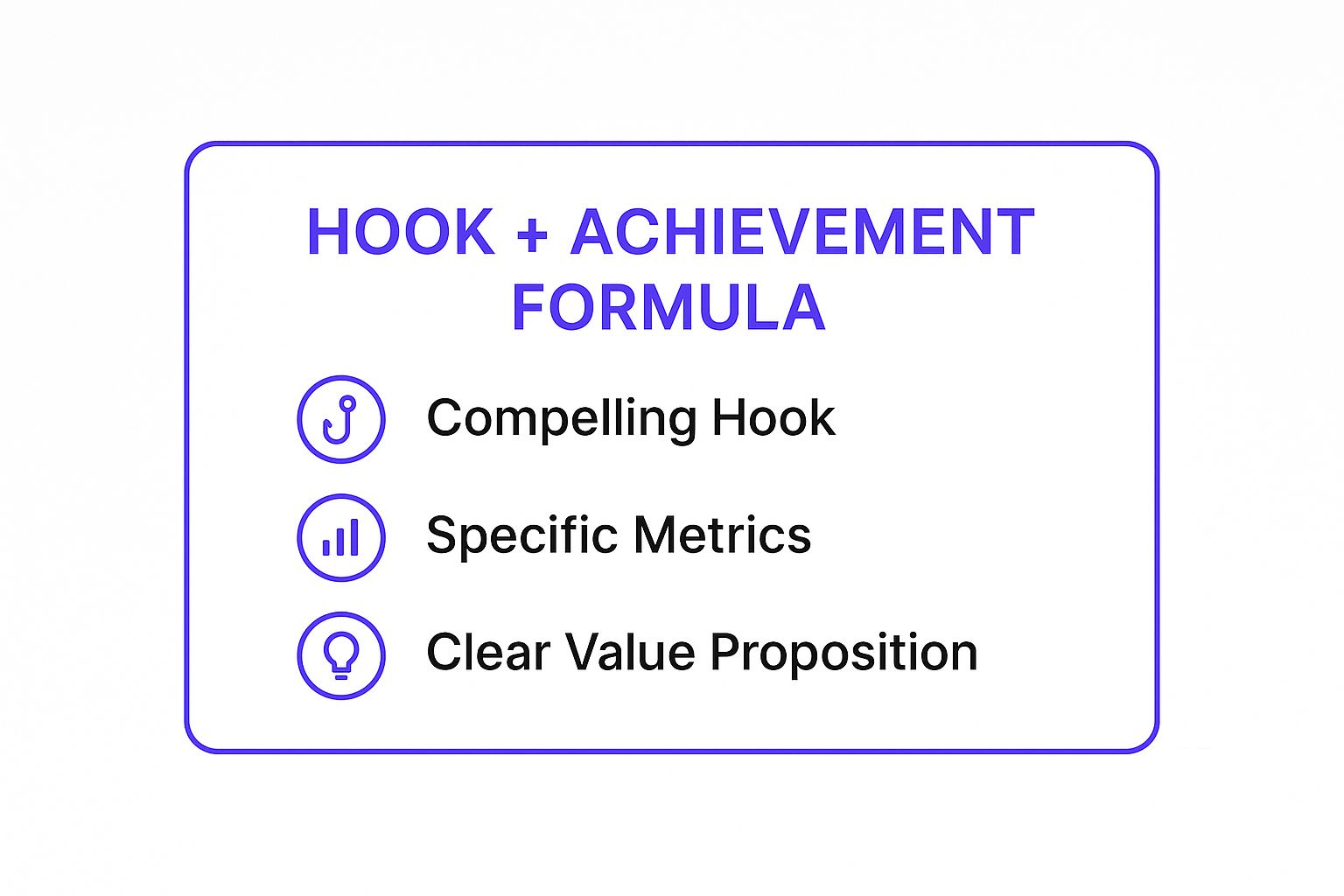
As the visualization highlights, combining a compelling hook with specific metrics creates a clear value proposition that is impossible to ignore. These three elements work together to build a powerful and persuasive professional narrative, making this formula a top-tier choice for anyone looking to make an immediate and lasting impression on their profile visitors.
2. The Problem-Solution Storyteller
Beyond just listing accomplishments, The Problem-Solution Storyteller approach frames your professional journey as a compelling narrative. This technique positions you as a strategic thinker who not only performs tasks but actively identifies and resolves critical business challenges. It’s an incredibly effective structure for a professional LinkedIn summary because it demonstrates your value proposition through a clear cause-and-effect story.

This method moves beyond a simple list of skills by connecting them directly to tangible outcomes. By presenting your experience as a series of problems faced, actions taken, and solutions delivered, you showcase your critical thinking, resourcefulness, and direct impact on an organization's success. This is particularly powerful for roles in management, consulting, and operations, where problem-solving is the core function.
Strategic Breakdown and Examples
Let's break down how to construct a narrative that highlights your problem-solving prowess. The key is to frame your contributions in a "before-and-after" context that a recruiter or potential client can easily grasp.
Example 1: HR Professional
- Problem: Faced with a costly 40% employee turnover rate that was impacting team morale and productivity.
- Solution: Designed and executed a comprehensive employee retention program, introducing mentorship initiatives, revised compensation benchmarks, and a clear career-pathing framework. This led to a 25% reduction in turnover within 12 months, saving an estimated $500K in annual recruitment and training costs.
Why It Works: This example doesn't just say "skilled in employee retention." It presents a specific, high-stakes problem (40% turnover) and details the strategic solution. The result is quantified in both percentage and dollar amounts, proving the professional's direct financial impact on the business.
Example 2: IT Manager
- Problem: Inherited a network infrastructure with significant security vulnerabilities and a history of recurring cyber threats.
- Solution: Championed a complete security overhaul, implementing multi-factor authentication, end-to-end data encryption, and company-wide cybersecurity training. Successfully mitigated 99% of identified vulnerabilities and fortified the company against potential data breaches, ensuring business continuity and client data protection.
Why It Works: This summary immediately establishes the professional as a proactive protector of the business. By outlining the initial "problem" (vulnerabilities, threats), it gives context to the "solution," making the achievement more impressive and demonstrating a forward-thinking, preventative mindset.
Actionable Takeaways: How to Implement This Formula
To build a professional LinkedIn summary using the Problem-Solution Storyteller method, think like a consultant analyzing a case study. Your career is the case study.
- Identify Core Problems: Brainstorm 2-3 significant challenges you've encountered in your roles. Think about inefficiencies, high costs, low performance, or strategic gaps. What were the biggest pain points you were hired or tasked to solve?
- Use the STAR Method: Structure your narrative using the STAR framework (Situation, Task, Action, Result). Briefly describe the situation (the problem), your task, the specific actions you took (the solution), and the measurable result. This creates a concise and powerful story.
- Connect to Broader Impact: Always link your solution to a larger business goal. Did you save money, increase revenue, improve security, boost customer satisfaction, or streamline operations? Frame your success in terms of the value you delivered to the entire organization.
- End with a Mission: Conclude your summary with a forward-looking statement about your current mission or the types of problems you are passionate about solving next. This shows ambition and gives readers a clear idea of how you can help them.
3. The Personal Brand Manifesto
While data-driven achievements are crucial, some professionals differentiate themselves through their vision, values, and purpose. The Personal Brand Manifesto is a summary style that functions like a personal mission statement. It moves beyond what you do and focuses on why you do it, articulating your core beliefs, unique perspective, and what you stand for within your industry. This approach is ideal for thought leaders, entrepreneurs, and executives who want to build a community and attract opportunities aligned with their values.
This style for a professional LinkedIn summary works by establishing an emotional and philosophical connection with the reader. Instead of leading with metrics, it leads with a powerful statement of purpose or a core belief. This positions you not just as a skilled practitioner but as a visionary and a leader driving change. It’s particularly effective for roles where influence, perspective, and cultural fit are paramount.
Strategic Breakdown and Examples
Let’s analyze how this manifesto approach creates a powerful, mission-driven professional narrative that resonates on a deeper level. The goal is to articulate your professional identity with conviction and clarity.
Example 1: Sustainability Advocate
- Belief Statement: I believe that sustainable business is not just a moral imperative but a powerful driver of long-term profitability and innovation. My mission is to embed environmental responsibility into the core of corporate strategy.
- Connecting to Outcomes: I partner with executive teams to develop and implement ESG frameworks that reduce carbon footprints by over 30%, unlock new green revenue streams, and enhance brand reputation for conscious consumers.
Why It Works: The summary opens with a strong, value-based "I believe" statement, immediately establishing the professional's core mission. It then brilliantly connects this high-level purpose to tangible business outcomes like cost reduction, revenue generation, and brand equity. This shows the value is both ethical and financial.
Example 2: Diversity and Inclusion Champion
- Belief Statement: True innovation is impossible without diverse voices at the table. I am dedicated to building inclusive tech cultures where every individual feels empowered to contribute their unique genius.
- Connecting to Outcomes: By redesigning hiring processes and launching mentorship programs, I've helped organizations increase representation of underrepresented groups in leadership by 40% and boost employee engagement scores by 25%.
Why It Works: This summary makes a bold, clear declaration of the professional’s "why." It frames D&I not as a compliance task but as a catalyst for innovation and business success. The specific metrics that follow prove that this values-driven approach yields measurable, positive results for the organization.
Actionable Takeaways: How to Implement This Formula
To write your own Personal Brand Manifesto, you must look inward to define your professional philosophy before you can communicate it outward.
- Start with Your Core Belief: What is the fundamental principle that guides your professional decisions? Write it down as a clear "I believe..." or "My mission is..." statement. This is the foundation of your summary.
- Connect Values to Business Outcomes: Your passion needs to have a practical application. Brainstorm how your values have led to positive results in your past roles. Did your people-first approach reduce turnover? Did your commitment to quality improve customer satisfaction?
- Use the First Person: This style demands authenticity. Writing in the first person ("I," "my") creates a direct, personal connection that is essential for a manifesto. It makes your professional LinkedIn summary sound confident and genuine.
- Include a Call-to-Action: Invite engagement. End your summary by encouraging like-minded individuals to connect. A simple line like, "If you share this vision for a more sustainable future, I'd love to connect," can be incredibly effective.
4. The Skills-First Showcase
In a world where recruiters and hiring managers often scan profiles for specific keywords and technical abilities, The Skills-First Showcase is a pragmatic and highly effective approach. This professional LinkedIn summary format immediately presents your core competencies, acting as a clear, scannable index of your expertise. It’s designed for specialists, technical professionals, and anyone whose value is intrinsically tied to a specific set of skills.
This structure flips the traditional narrative summary on its head. Instead of burying your most valuable, searchable skills within paragraphs of text, you lead with them. This directness makes it incredibly easy for profile visitors to confirm you have the qualifications they’re looking for, often within seconds. It’s a strategy rooted in clarity and efficiency, ensuring that your most critical attributes are the first thing a reader sees.

Strategic Breakdown and Examples
The goal here is to optimize for both human scanners and search algorithms by front-loading your most relevant, high-value keywords. Let’s break down how this works for different roles.
Example 1: Software Engineer
- Skills Showcase: Core Competencies: Python, Java, AWS, Docker, Kubernetes, CI/CD Pipelines, Agile Methodologies.
- Context/Achievement: With 8+ years of experience, I build scalable, high-availability backend systems and lead cloud migration projects. I recently re-architected a legacy monolith into a microservices-based system, improving deployment frequency by 400% and reducing server costs by 30%.
Why It Works: A technical recruiter immediately sees the required tech stack. The skills list acts as a perfect filter, and the follow-up sentence provides crucial context and a powerful, quantified achievement that demonstrates the impact of those skills.
Example 2: Digital Marketer
- Skills Showcase: Areas of Expertise: SEO/SEM, Google Analytics (GA4), Meta Ads, Content Strategy, Email Marketing Automation (HubSpot), A/B Testing.
- Context/Achievement: I develop and execute data-driven digital marketing strategies that boost lead generation and conversions. I led a recent SEO overhaul that increased organic traffic by 150% in six months and managed a Meta Ads campaign with a 5x ROAS.
Why It Works: This summary immediately communicates proficiency with specific, in-demand marketing platforms and strategies. The subsequent results directly link these skills to tangible business outcomes like traffic growth and return on ad spend, proving their practical value.
Actionable Takeaways: How to Implement This Formula
To effectively build a Skills-First Showcase, you need to be strategic about which competencies you highlight.
- Curate Your Skills List: Don’t list everything. Select 5-7 of your most valuable and relevant skills for the roles you are targeting. Think about what a recruiter would type into the search bar.
- Balance Hard and Soft Skills: While this format leans toward technical abilities, including one or two key soft skills (e.g., "Agile Methodologies," "Cross-Functional Leadership") can add important context and depth.
- Provide Concise Context: After your skills list, add a brief 1-2 sentence statement that explains how you use these skills. Connect them to your core function or professional mission.
- Follow with a Key Result: End with a powerful, quantified achievement that proves your skills deliver results. This bridges the gap between knowing what you can do and proving how well you do it.
5. The Industry Expert Authority
Moving beyond direct performance metrics, The Industry Expert Authority format is designed for professionals whose value is tied to their reputation, thought leadership, and recognized expertise. This approach builds a professional LinkedIn summary that establishes credibility not just through job accomplishments, but through industry-wide recognition. It’s ideal for seasoned executives, influential consultants, published authors, and anyone whose personal brand is a significant professional asset.
This format works by strategically showcasing third-party validation and intellectual contributions. Instead of focusing solely on internal achievements, it highlights external proof of your expertise, such as publications, speaking engagements, media features, and industry awards. This shifts the narrative from "I am good at my job" to "My industry recognizes me as a leading voice," which is incredibly persuasive for attracting high-level opportunities, consulting gigs, and board positions.
Strategic Breakdown and Examples
Let’s analyze how this format positions a professional as a definitive authority. The goal is to build a narrative of influence that extends beyond a single company or role.
Example 1: Cybersecurity Consultant & Published Author
- Authority Statement: Internationally recognized cybersecurity strategist and author of "The Digital Fortress," dedicated to helping Fortune 500 companies navigate emerging cyber threats.
- Proof Points: Featured expert on BBC News and in Forbes for analysis on state-sponsored cyber-attacks. Keynote speaker at DEF CON and Black Hat USA. My work has influenced national data privacy policies and has been cited in over 50 academic journals.
Why It Works: This summary immediately establishes authority with the title "author" and the book's name. It then provides powerful social proof through named, high-prestige media outlets (BBC, Forbes) and top-tier industry conferences (DEF CON, Black Hat). The final sentence quantifies influence in a way that is far more impactful than a simple job title.
Example 2: C-Suite Healthcare Executive
- Authority Statement: A C-level healthcare executive and board member with a proven track record of driving innovation in patient care technology and health system management.
- Proof Points: Recipient of the "Healthcare Innovator of the Year" award. Published in the New England Journal of Medicine. Regularly speak on panels at the World Health Summit about the future of digital health and policy reform.
Why It Works: The summary leads with high-level roles (C-level, board member) and then substantiates this status with concrete, prestigious validation. A specific award, a top-tier journal publication, and a globally recognized summit create an undeniable impression of expertise and influence in the healthcare sector.
Actionable Takeaways: How to Implement This Format
To craft your own authority-driven professional LinkedIn summary, you need to inventory your moments of industry recognition.
- List Your Accolades: Brainstorm all external validation points. This includes awards, media mentions (podcasts, articles, TV), speaking engagements (conferences, panels, webinars), publications (books, articles, research papers), and prestigious board or committee memberships.
- Lead with Your Strongest Claim: Start your summary with your most powerful identifier. Are you an "award-winning CMO," a "published author," or a "keynote speaker"? Place that front and center.
- Be Specific and Name-Drop: Vague claims like "spoken at conferences" are weak. Instead, write "Keynote Speaker at INBOUND 2023" or "Featured in The Wall Street Journal." Naming the specific, reputable platform transfers its credibility to you.
- Balance Authority with Approachability: While the goal is to establish expertise, avoid sounding arrogant. Conclude with a statement about your mission or passion, such as "Passionate about mentoring the next generation of leaders" or "Committed to making technology more accessible," to add a human element.
6. The Conversational Connector
In a world of automated messages and formal business jargon, the Conversational Connector approach stands out by being refreshingly human. This professional LinkedIn summary style swaps rigid, third-person descriptions for a warm, first-person narrative that feels like the start of a genuine conversation. It's designed to make you seem approachable, relatable, and authentic, building an immediate connection with profile visitors.
This strategy works by lowering the traditional corporate barrier. It uses "I" statements, asks engaging questions, and sometimes shares a glimpse of personal interests or professional philosophy. Instead of just listing qualifications, you are inviting recruiters, potential clients, and industry peers into your world, making it easier for them to envision working with you. This is particularly effective in roles where personality and relationship-building are just as important as technical skills.
Strategic Breakdown and Examples
Let’s analyze how this friendly approach translates into a powerful professional LinkedIn summary. The goal is to create a personal brand that is both professional and personable, fostering trust and encouraging outreach.
Example 1: HR Professional (Focus on Culture)
- Hook: "I believe a great company culture isn't built with free snacks; it's built with trust, transparency, and genuine care for people. My job is to bring that philosophy to life."
- Connection: "With over 8 years in people operations, I've helped tech startups scale from 50 to 500+ employees while maintaining a 92% employee satisfaction rating. I'm passionate about creating workplaces where everyone feels valued and empowered to do their best work. Have a question about building an inclusive team? I'm always happy to chat."
Why It Works: The hook establishes a strong, relatable professional philosophy. The summary then provides concrete proof (scaling a company, 92% satisfaction) while maintaining a warm tone. The closing question is a direct invitation to connect, making the professional highly approachable.
Example 2: Startup Founder
- Hook: "Let's be honest: building a startup is a chaotic, thrilling, and sometimes terrifying adventure. I wouldn't have it any other way."
- Connection: "As the founder of InnovateRight, I'm obsessed with solving complex supply chain problems for small businesses. We recently helped our clients reduce logistics costs by an average of 18% in just six months. I'm always looking to connect with other innovators, investors, and anyone who believes in using tech to empower entrepreneurs. What problem are you trying to solve?"
Why It Works: This summary uses candid language ("chaotic," "terrifying") that resonates deeply with its target audience of entrepreneurs and investors. It balances this authentic tone with a hard metric (18% cost reduction) and ends with a powerful, open-ended question that sparks curiosity and encourages engagement.
Actionable Takeaways: How to Implement This Formula
To craft your own conversational summary, focus on revealing your professional personality without sacrificing credibility.
- Write in the First Person: Use "I" and "my" throughout your summary. This is the foundation of the conversational style and makes your profile feel personal and direct.
- Start with Your 'Why': Lead with your core belief, passion, or professional mission. What gets you excited about your work? This creates an immediate emotional connection.
- Ask a Question: End your summary with a question directed at the reader. This can be about their challenges, goals, or interests, and it serves as a powerful call-to-action for engagement.
- Balance Personality with Proof: While the tone is friendly, remember to include 1-2 key achievements with quantifiable results. This ensures your personable approach is backed by professional substance. Frame your accomplishments as part of your story.
6 Professional LinkedIn Summary Styles Compared
| Summary Style | Implementation Complexity 🔄 | Resource Requirements ⚡ | Expected Outcomes 📊 | Ideal Use Cases 💡 | Key Advantages ⭐ |
|---|---|---|---|---|---|
| The Hook + Achievement Formula | Medium - requires significant achievements and precise crafting | Moderate - needs specific metrics and quantifiable results | High - immediate attention, credibility through concrete results | Mid to senior-level professionals with strong track records | Grabs attention quickly; shows measurable impact; easy to scan |
| The Problem-Solution Storyteller | Medium to High - requires structured problem framing and narrative | Moderate to High - demands deep understanding of business challenges | High - demonstrates strategic thinking and value addition | Strategic roles, consultants, senior management | Highlights strategic thinking; showcases business acumen; versatile across industries |
| The Personal Brand Manifesto | Medium - needs strong self-awareness and clear articulation | Low to Moderate - based on values and perspective expression | Medium to High - builds emotional connection and personal brand authority | Entrepreneurs, consultants, speakers, senior execs | Differentiates from generic summaries; creates emotional engagement |
| The Skills-First Showcase | Low - straightforward listing and keyword optimization | Low - compiling and updating skill sets | Medium - facilitates quick recruiter match and ATS optimization | Technical professionals, specialists, skill-dependent roles | ATS-friendly; quick match for recruiters; clear expertise focus |
| The Industry Expert Authority | High - requires substantial achievements and authority indicators | Moderate to High - includes awards, publications, and recognition | High - establishes credibility and attracts high-level opportunities | Senior executives, consultants, recognized experts | Immediate credibility; attracts consulting/speaking opportunities |
| The Conversational Connector | Low - uses friendly tone and personal elements | Low - informal language and narrative style | Medium - builds approachable personal connection | Creative roles, startups, sales, relationship-focused jobs | Creates rapport and culture fit; encourages networking and engagement |
Crafting Your Signature: Moving from Example to Execution
We’ve journeyed through a diverse landscape of professional LinkedIn summary examples, deconstructing what makes each one powerful and effective. From the direct impact of the Hook + Achievement Formula to the compelling narrative of the Problem-Solution Storyteller, you’ve seen that there is no single “correct” way to write your summary. The most effective approach is the one that authentically represents your unique professional identity and resonates with your target audience.
The goal was never to provide a template for you to copy and paste. Instead, the purpose of analyzing these distinct styles, like the bold Personal Brand Manifesto or the data-driven Skills-First Showcase, was to equip you with a toolkit of strategies. Your task now is to select, combine, and adapt these techniques to build a professional LinkedIn summary that is uniquely yours.
Synthesizing the Strategies for Your Professional Profile
The true power lies not in choosing one formula but in understanding the strategic purpose behind each. Think of these approaches as ingredients. You might start with the directness of the Industry Expert Authority model to establish credibility, then weave in the relatability of the Conversational Connector to make yourself more approachable.
Remember the core principles we've uncovered:
- Clarity Over Complexity: A clear, concise message will always outperform a dense, jargon-filled paragraph. Your summary must be scannable and immediately understandable.
- Audience First, Always: Who are you trying to reach? A recruiter? A potential client? A future collaborator? Tailor your language, tone, and the problems you highlight to speak directly to their needs and goals.
- Show, Don't Just Tell: Instead of saying you are "results-oriented," share a specific, quantified achievement. This transforms a generic claim into a compelling proof point.
- Inject Your Personality: Your summary is the one place on your LinkedIn profile where your voice can truly shine. Don't be afraid to show some personality; it’s what makes you memorable and human.
Your Actionable Blueprint for a Winning Summary
Feeling inspired is one thing; taking action is another. It's time to move from passive learning to active creation. Don't let the "perfect" be the enemy of the good. Start drafting now, even if it feels clunky at first.
Follow these steps to build your new professional LinkedIn summary:
- Define Your Goal: What is the #1 action you want a reader to take after reading your summary? (e.g., connect with you, visit your portfolio, schedule a call). This goal will be your North Star.
- Identify Your Core Message: If a reader could only remember one thing about you, what would it be? Is it your expertise in AI-driven marketing, your talent for scaling startups, or your passion for sustainable design?
- Draft with a Framework: Choose one of the six models from this article as your starting point. Don't worry about getting it perfect. Just get the basic structure and key information down on paper.
- Refine and Optimize: Reread your draft. Is the hook strong? Are your achievements quantified? Have you included relevant keywords naturally? This is where you polish your message. To inspire your own writing, we've provided some strategies and you can explore additional LinkedIn About Me examples for more ideas.
- Publish and Evolve: Your LinkedIn summary is not set in stone. It's a living document that should evolve as your career progresses. Publish your new version and be prepared to tweak it based on the connections and opportunities it generates.
Ultimately, your LinkedIn summary is more than just a block of text; it's your digital handshake, your professional story, and your personal brand's frontline. Investing the time to craft it with intention is one of the highest-leverage activities you can undertake for your career. You now have the strategies and insights to build a professional LinkedIn summary that doesn't just list your skills, but truly sells your value.
Ready to move beyond the summary and accelerate your professional growth with the power of AI? MakerBox provides the tools and insights you need to leverage AI for everything from content creation to marketing, helping you build and scale your projects faster. Discover the AI-powered strategies that top creators and entrepreneurs are using at MakerBox.
